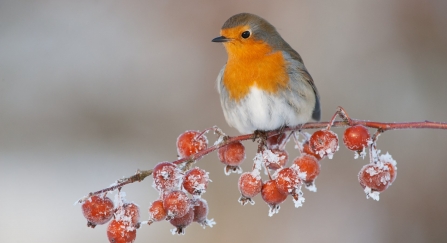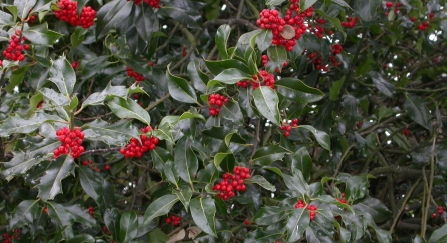
Why we decorate with holly at Christmas and other festive traditions
Holly by Ross Hoddinott

When we think of wildlife associated with Christmas, the robin will probably rank top of many lists. Dating back to Victorian times, when postmen wore red tunics and were nicknamed ‘robin redbreasts’, the bird of the same name began appearing on Christmas cards to represent these messengers.
The robin has twice been declared Britain’s national bird (in 1961 and more recently in 2015) and is a beloved visitor to many gardens. Robins can be heard singing throughout winter and so may treat you to a merry tune on Christmas Day!

Frosty mistletoe by Zsuzsanna Bird
Kissing under the mistletoe is another well-loved Christmas tradition, although the plant itself can be found in many stories, including Norse and Greek mythology.
The origin of this festive custom is somewhat unclear (and probably connected to those older myths) although many link it to the fact that mistletoe is seen as a symbol of vitality and fertility due to its evergreen nature.
A parasitic plant, its green leaves and white berries stand out amongst the bare branches of the host tree in winter.
The kissing tradition became popular amongst servants in the 18th century, when the rules stated that one kiss could be granted for each berry plucked from the plant.
Don’t be tempted to eat them though – although mistletoe berries are a favourite of birds like blackcaps, they’re poisonous to humans.

Holly and ivy are two more evergreen plants that are closely associated with the festivities. With its shiny green leaves and red berries, the former is a common Christmas decoration and prior to Victorian times the term ‘Christmas tree’ actually referred to holly.
Beware before considering it as an alternative to the now traditional fir tree though, as it’s considered bad luck to cut down a whole holly tree!
Holly, ivy and other greenery were also used during winter solstice celebrations to ward off evil spirits and celebrate new growth. In pagan times, holly was thought to be the male plant and ivy the female.
One old tradition from the Midlands says that whichever plant enters the house first in winter will dictate whether the males or females rule the home for the following year – although bringing either inside before Christmas Eve is again said to be unlucky.

And what about the star of the popular ‘Twelve Days of Christmas’ carol: the partridge?
Well, those heading out for a walk in the countryside may well spot one of these gamebirds running along the ground – but sadly not in any pear trees!
Festive Wildlife Detective
Have a bit of fun wildlife-spotting this Christmas. Can you find ten of the Twelve Days of Christmas?
Click on the image to download a pdf.
Stay up-to-date with our work
Sign up below to receive the latest news from BBOWT, tips about how you can help wildlife, plus information on how you can get involved.

